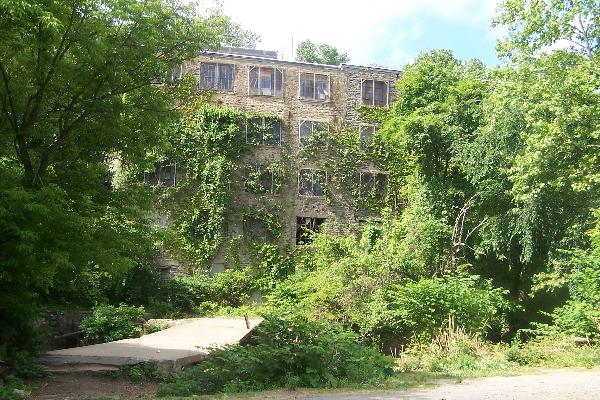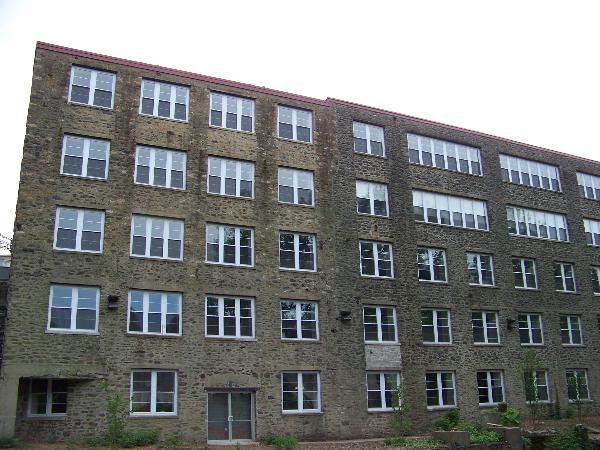Rockbourne Mills
Rockbourne Mill was a cotton-mill owned by Samuel Garrett. In 1837, Garrett's health began to fail and the mill changed ownership between family members before finally landing in the hands of Edwin Garrett on April 1, 1838. Edwin Garrett rented the mill to Jonas Cowan, who made cotton laps until the fall of 1842, when John and James Wilde took over the lease.
Thomas Kent, an already successful textile businessman in England, came to America in 1839 to work with his brother-in-law James Wilde in the mills on Darby Creek, Rockbourne being one of them. In 1843, Thomas and his brother John went into business for themselves as co-partners under the firm-name of J. & T. Kent. They rented a former linseed oil mill (once owned by Samuel Garrett) from brother-in-law James, where they manufactured carpet-yarns.
Then on August 5, 1843 a major flood hit washed away many of the mills along the creek. The flood, and a disastrous fire that followed, destroyed the Kents' mill and machinery. Undaunted, the brothers took over the lease of nearby Rockbourne Mill in the fall of that year, which was fully equipped with machinery, and in active operation manufacturing woolen goods by January 1, 1844.
Between 1845 and 1846, the Kent Brothers made the purchase of Rockbourne Mill from Edwin Garrett as well as the Union Mills (located directly across the creek), from current owner, James Wilde, and the Eckstein paper mill. The Kents enlarged the mills and converted them all to manufacture woolen cloth. In 1850, Rockbourne Mill received an addition of thirty by forty feet that consisted of four stories and an attic.
The Kent co-parnership ended in 1852 when Thomas Kent bought his brother's half of the business. The same year he introduced the weaving of Kentucky jeans, and continued production until 1861, when the mill was devoted to the manufacture of cloth for Civil War uniforms.
Most of the old mills were upgraded in 1867. That year, the old part of Rockbourne Mill was almost completely demolished and a stone structure fifty-four by one hundred and twenty-five feet, four stories and attic, was erected. The production of cloths was continued until 1877, when flannels were made a specialty, and were still the product of the looms twenty years later.
The mill contained six mules with four hundred spindles each, five sets of cards, and thirty-eight broad looms. Twenty-four hundred yards of woolen goods were manufactured weekly. The machinery was driven by a one hundred horse-power engine and one hundred and twenty horse-power boiler. Two hundred people were employed in the combined Kent Mills by the year 1884.
When Thomas Kent died in Clifton Heights in October 1887, his son, Henry Thomas Kent, took control of the mills. Henry was a Cornell University graduate, a shrewd businessman and the one responsible for the lasting growth of the Thomas Kent Manufacturing Company. When he died in 1918, his son, Everett L. Kent, became president.
In 1900 and 1910 additional mills named Runnymede, were added and used to spin worsted yarns. The Kent Mills remained in business long after the other Darby Creek mills. They supplied uniform cloth to the government during the Mexican War, Civil War, Spanish-American War, World Wars I and II, and the Korean War. The January 28, 1943 issue of the Clifton Heights News commemorated the 100th anniversary of the mills. That year Russell L. Kent was the Assistant Treasurer, and 800 people were employed by the corporation, and nearly all lived within five miles of the mills. The mills remained in operation until around 1955.
The Rockbourne Mill building still stands today. What happened to the mill from 1955 to present day? In the recent past, the building was used as a warehouse for Drexel Hill Furniture. Then it must have lay abandoned for several years.
It was during a bike ride in May 2006 when I first came across the massive, run-down, ivy-covered stone structure looming over Darby Creek. I was instantly fascinated. "Whoa", I think I said. An older gentleman fishing nearby noticed me and nodded. "What was it?" I asked. "Oh, that's the old yarn mill," he said and recounted the days when kids used to go swimming in the creek and come home different colors depending on the color yarn they were dying that day.
In 2007, the building was purchased with the intent to turn it into a state of the art Business Center called Rockbourne Falls. That dream could have been wiped out during an electrical fire involving numerous downed electric wires, on two poles and a transformer, as well as a fire inside the building at an electric panel, if not for the fast work of the firefighters.
Other Places of Interest
Adjacent to Rockbourne Mills is Kent Park, recently renovated into a dog park. Once a part of the Thomas Kent Estate, the park was named in his honor.
The parking coordinates place you right beside the recycling bins (did somebody say CITO?) and in front of some interesting ruins on the hill. There is a plaque on the ruins with some names. These are most likely the remains of the original bridge that crossed Darby Creek in the 1800s. In this map of Clifton Heights from 1892, you can clearly see the old bridge and both Rockbourne and Union Mills (right under the map title).
While searching for the cache, you may stumble upon some of the remains of what was once Union Mill.
Follow the creek upstream from the cache a bit, past the old mill building (look for the trail and listen for the falls) and you will find the dam which powered the mill and from which the current business center took its name. Parts of this dam may be as old as 200 years, built by Samuel Garrett's brother Thomas in 1808... That is if the flood of 1843 didn't wash it completely away.
If you're up for a walk, continue to follow the trail past the falls and it will lead you up alongside the trolley bridge to Creek Road. There, you can continue along Creek Road to find an additional cluster of hidden caches. On the trail, you will pass some neat ruins of an old mill house on your right. A word of note: In the summer months, many of the neighborhood kids like to hang out back here. Most are friendly, just be aware that it may be a little busy at times.


About This Cache
From the day I first came here, I thought this would be the perfect location for a cache. I love to look at old things and imagine how they used to be. This old mill had a story to tell and I wanted to be the one to tell it. And now, it's even more wonderful to see the building remodeled and the name kept. Sadly, far too often historic buildings are torn down to make room for progress. We recently lost the old Fernwood School building on Baltimore Pike for yet another Rite Aid. Preserving this building also preserves a bit of the rich mill history that was once such an important livelihood for these Delaware County communities. I hope this mill and its history fascinates you as much as it did me.
Current cache (as of 4/10/17) is a well-camouflaged bison, in place since 05/12/2012.
CONGRATS TO HNDLBR FOR FTF!! I knew he would be. ;D